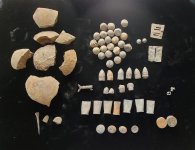LawrencetheMDer
Hero Member
- Feb 22, 2014
- 984
- 2,395
- 🏆 Honorable Mentions:
- 2
- Detector(s) used
-
Minelab Manticore, Minelab CTX3030 w 11" and 17" DD coils,
Minelab Excalibur II w 10" coil, Equinox 800 (4) w 11" and 15" coils,
Troy Shadow x2 w 7" coil, Pointers; Garrett Carrot, Pro Find 35,
- Primary Interest:
- Beach & Shallow Water Hunting
In a continuing investigation into the relationship between CTX 3030 CO number and target characteristics, I have previously shown that CTX 3030 CO number is highly dependent on target weight; as target weight increases so does CO number. The relation between CO number and target weight has found to hold for lead (fishing weights), aluminum foil and gold (rings and coins).
However, in these investigations when weight was increased there was a natural increase in size (surface area) as well. Lets face it, when a target of the same composition increases in weight it also increases in size (I also know this from personal experience with pants size!). Any ways, to uncouple the effects of target weight vs target size on CO number, I decided to record CO number with different sizes (surface areas) of aluminum foil while keeping the weight of the target (1.96g) the same by using the same piece of foil for all sizes.
I took an 8" x 8" single sheet of aluminum foil while holding distance constant from the coil at about 6" and measured the CO number with the CTX 3030. I then folded the single piece of foil to match the listed surface sizes on Table 1. The largest size of aluminum foil was 8" x 8" (64 sq in) and the smallest size was 0.75" x 0.50" (.375 sq in); I couldn't fold the single piece of foil smaller. The left-hand side of Table 1 shows for 1.96g the size of the aluminum foil surface area facing parallel to the 17" coil and corresponding CO number. Note that as target surface area increased the CTX 3030 CO number decreased and finally plateau around a CO of 20 for the 1.96g of aluminum foil at 16 sq in.
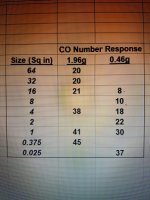
Table 1.
Figure 1 solid line shows the relation between surface area and CO number while weight was constant at 1.96g across all surface areas. Note that the CO number didn't change much if at all after surface area increased greater than 4" x 4" (16 sq in) for the approx 2g sheet of foil. At the smaller sizes from .375 sq inch to 16 sq inches there is a near perfect inverse linear relation between target size and CO number (R= -0.99, almost perfect negative correlation); as foil size increased CO number decreased proportionately.
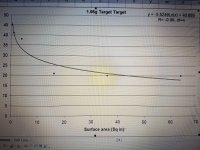
Figure 1.
Next I took a 4" x 4" piece of foil that measured 0.46g and basically repeated the experiment with the smallest size being 0.5" x 0.5" (.25 sq in). The right side of Table 1 shows the foil size (sq in) and the corresponding CO number. Again note that as foil size (surface area) increased, while holding weight constant, CO number decreased. Graph 2 shows the results of the 0.46g foil study and the relation between foil surface area and CO number is best fitted by the solid line with almost perfect fit. Again, there is a systematic decline in CO number as surface area increased (Figure 2).
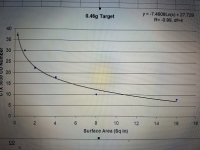
Figure 2.
Figure 3 shows the results of the 1.96g (2g) and 046g (0.5g) foil weights on CO number with change of surface area. Weight shifts the function up (more weight) and down (less weight) along the Y-axis and these results are consistent with my previous studies showing the there is a direct relationship between weight and CO number; as weight increases so does the CO number. The fitted lines reflect a log function and show the effects of surface size on CO number; as surface area increases CO number decreases. But there seems to be a limit of about 16 sq in ( for the 17" coil) where surface area no longer affects CO number. This appears to be the case for both the 2g and 0.5g foil weights. For both weights, the CO response flattens out at 16 sq in.
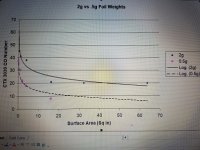
Figure 3.
The results of numerous studies on the effect of target weight on CTX 3030 CO number show that as target weight increases, CO number increases proportionately (for aluminum foil, lead, gold rings, gold coins). I have also demonstrated that as size increases, while weight is held constant, CO number decreases. Normally, when a target increases in weight it also increases in size (surface area). The increase in target size due to an increase in weight would serve to somewhat decrease the CO number given the finding that CO number decreases with an increase in size. But the negative CO size effect is more than off-set by the positive CO weight effect and, thus, as weight (and size) increased the CO number also increased.
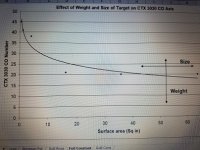
Figure 4.
Figure 4 helps to illustrate the relationship among target weight, target size (surface area) and CTX 3030 CO number. The up-down arrows on the right illustrate the effects of target weight on the whole fitted solid line; as target weight changes the whole CO function moves up or down the Y-axis depending on whether weight increases (function moves up) or weight decrease (whole function moves down the Y-axis). Heavier targets yield higher CO numbers regardless of size and lighter targets yield lower CO numbers regardless of size.
The left-right arrows in Figure 4 illustrate the effects of size on the CO number. A change in size causes the CO response to move along the solid (regression) line and the effects of target size is the opposite of that reported for weight (negative correlation); As size increased the CO number decreased along the solid function line, but only for relatively smaller targets (<16 sq in). At larger foil target sizes, the CO number remained constant regardless of size.
In conclusion, target weight and target size both play a significant role in the generation of the CTX 3030 CO number. Target weight is the main driver of the CTX 3030 CO number and determines the height of the CO response function. Size serves to move the CO number along the CO weight function. As a consequence, the CO axis on the CTX 3030 can be considered a measure of target weight, to the first approximation, and lighter targets will fall at the lower end of the CO axis and heavier targets will fall toward the higher end of the CO axis.
One conclusion from my studies of target characteristics and CO nunber is that gold can fall anywhere along the CO axis with the primary factor being weight of the target. From a practical point of view, I am a Metal Detectorist by-the-way, these data strongly suggest that to maximize gold recovery one should dig all targets on the FE 12 line (I use FE 9-15 to cover environmental influences) regardless of CO number. Unfortunately, situations exist where time for digging every good target is not an option (e.g., low tide hunting, night hunting, too many target and limited time). In these situations, CO numbers corresponding to pull-tabs and push-tabs (e.g., 12:15-23), for example, could be filtered out or ignored when necessary but with the full realization that some gold rings of particular weight will fall within the filtered or ignored CO numbers. In the present case, for example, if one were to ignore 12:15-23 CO numbers because of excessive pull-tabs and push-tabs, one would have missed 15% (4/27) of the gold rings I had analyzed earlier when assessing the effects of gold ring weight on CO number. Gold rings appeared at 12:16, 12:17 (2) and 12:18, and would have been missed because they're in rejected/ignored pull-tab and push-tab CO ranges. Beware and Happy hunting
However, in these investigations when weight was increased there was a natural increase in size (surface area) as well. Lets face it, when a target of the same composition increases in weight it also increases in size (I also know this from personal experience with pants size!). Any ways, to uncouple the effects of target weight vs target size on CO number, I decided to record CO number with different sizes (surface areas) of aluminum foil while keeping the weight of the target (1.96g) the same by using the same piece of foil for all sizes.
I took an 8" x 8" single sheet of aluminum foil while holding distance constant from the coil at about 6" and measured the CO number with the CTX 3030. I then folded the single piece of foil to match the listed surface sizes on Table 1. The largest size of aluminum foil was 8" x 8" (64 sq in) and the smallest size was 0.75" x 0.50" (.375 sq in); I couldn't fold the single piece of foil smaller. The left-hand side of Table 1 shows for 1.96g the size of the aluminum foil surface area facing parallel to the 17" coil and corresponding CO number. Note that as target surface area increased the CTX 3030 CO number decreased and finally plateau around a CO of 20 for the 1.96g of aluminum foil at 16 sq in.

Table 1.
Figure 1 solid line shows the relation between surface area and CO number while weight was constant at 1.96g across all surface areas. Note that the CO number didn't change much if at all after surface area increased greater than 4" x 4" (16 sq in) for the approx 2g sheet of foil. At the smaller sizes from .375 sq inch to 16 sq inches there is a near perfect inverse linear relation between target size and CO number (R= -0.99, almost perfect negative correlation); as foil size increased CO number decreased proportionately.

Figure 1.
Next I took a 4" x 4" piece of foil that measured 0.46g and basically repeated the experiment with the smallest size being 0.5" x 0.5" (.25 sq in). The right side of Table 1 shows the foil size (sq in) and the corresponding CO number. Again note that as foil size (surface area) increased, while holding weight constant, CO number decreased. Graph 2 shows the results of the 0.46g foil study and the relation between foil surface area and CO number is best fitted by the solid line with almost perfect fit. Again, there is a systematic decline in CO number as surface area increased (Figure 2).

Figure 2.
Figure 3 shows the results of the 1.96g (2g) and 046g (0.5g) foil weights on CO number with change of surface area. Weight shifts the function up (more weight) and down (less weight) along the Y-axis and these results are consistent with my previous studies showing the there is a direct relationship between weight and CO number; as weight increases so does the CO number. The fitted lines reflect a log function and show the effects of surface size on CO number; as surface area increases CO number decreases. But there seems to be a limit of about 16 sq in ( for the 17" coil) where surface area no longer affects CO number. This appears to be the case for both the 2g and 0.5g foil weights. For both weights, the CO response flattens out at 16 sq in.

Figure 3.
The results of numerous studies on the effect of target weight on CTX 3030 CO number show that as target weight increases, CO number increases proportionately (for aluminum foil, lead, gold rings, gold coins). I have also demonstrated that as size increases, while weight is held constant, CO number decreases. Normally, when a target increases in weight it also increases in size (surface area). The increase in target size due to an increase in weight would serve to somewhat decrease the CO number given the finding that CO number decreases with an increase in size. But the negative CO size effect is more than off-set by the positive CO weight effect and, thus, as weight (and size) increased the CO number also increased.

Figure 4.
Figure 4 helps to illustrate the relationship among target weight, target size (surface area) and CTX 3030 CO number. The up-down arrows on the right illustrate the effects of target weight on the whole fitted solid line; as target weight changes the whole CO function moves up or down the Y-axis depending on whether weight increases (function moves up) or weight decrease (whole function moves down the Y-axis). Heavier targets yield higher CO numbers regardless of size and lighter targets yield lower CO numbers regardless of size.
The left-right arrows in Figure 4 illustrate the effects of size on the CO number. A change in size causes the CO response to move along the solid (regression) line and the effects of target size is the opposite of that reported for weight (negative correlation); As size increased the CO number decreased along the solid function line, but only for relatively smaller targets (<16 sq in). At larger foil target sizes, the CO number remained constant regardless of size.
In conclusion, target weight and target size both play a significant role in the generation of the CTX 3030 CO number. Target weight is the main driver of the CTX 3030 CO number and determines the height of the CO response function. Size serves to move the CO number along the CO weight function. As a consequence, the CO axis on the CTX 3030 can be considered a measure of target weight, to the first approximation, and lighter targets will fall at the lower end of the CO axis and heavier targets will fall toward the higher end of the CO axis.
One conclusion from my studies of target characteristics and CO nunber is that gold can fall anywhere along the CO axis with the primary factor being weight of the target. From a practical point of view, I am a Metal Detectorist by-the-way, these data strongly suggest that to maximize gold recovery one should dig all targets on the FE 12 line (I use FE 9-15 to cover environmental influences) regardless of CO number. Unfortunately, situations exist where time for digging every good target is not an option (e.g., low tide hunting, night hunting, too many target and limited time). In these situations, CO numbers corresponding to pull-tabs and push-tabs (e.g., 12:15-23), for example, could be filtered out or ignored when necessary but with the full realization that some gold rings of particular weight will fall within the filtered or ignored CO numbers. In the present case, for example, if one were to ignore 12:15-23 CO numbers because of excessive pull-tabs and push-tabs, one would have missed 15% (4/27) of the gold rings I had analyzed earlier when assessing the effects of gold ring weight on CO number. Gold rings appeared at 12:16, 12:17 (2) and 12:18, and would have been missed because they're in rejected/ignored pull-tab and push-tab CO ranges. Beware and Happy hunting
Upvote
0


